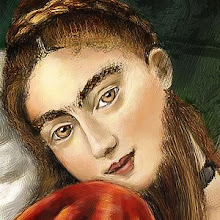 When looking at Louis XVII’s portrait, it’s hard to imagine that this regal boy could have endured such suffering. Everyone has heard the tragic end to his famous parents, but the boy king remains merely a footnote in France’s history of the Revolution.
When looking at Louis XVII’s portrait, it’s hard to imagine that this regal boy could have endured such suffering. Everyone has heard the tragic end to his famous parents, but the boy king remains merely a footnote in France’s history of the Revolution.Louis XVII was the second son of Louis XVI and Marie Antoinette. To Marie, Louis was her beloved “chou d’amour.” To Revolutionary France, he was the “wolf cub” and the unknowing target of France’s hatred toward the monarchy.
During the Revolution, Louis was literally ripped from his mother's arms. While confined in the Temple Prison, Marie could hear the cries of her son in the room below hers, but she was not allowed to see him. Louis’s companions were rats and his prison ward, Antoine Simon. The rats were kinder. Simon repeatedly beat Louis and forced him to drink large quantities of alcohol. There are rumors that he even forced him to sleep with diseased prostitutes. Louis was only eight years old.
Louis’s living conditions got even worse when he was placed into solitary confinement. His new prison had little light and worst of all, no housekeeping. In the years he was left to rot, no one bothered to remove the piles of feces. Louis soon became despondent. When asked why he wouldn’t speak he quietly muttered, “I want to die.”
Louis’s jailers fed his flesh slowly to the revolution’s hate machine. His parents’ death ended quickly.
If you are interested in learning more about Louis XVII and enjoy a good conspiracy tale, I highly recommend The Lost King of France by Deborah Cadbury. After Louis’s death, rumors spread that he had actually escaped his prison in a wicker basket. What if the boy who died in prison was not really Louis, but a substitute king? These rumors caused a slew of pretenders to come forward claiming to be the king of France and causing much heartache for Louis’s surviving sister, Marie Therese.
Cadbury intertwines the aftermath of Louis’s supposed death with a grisly relic's journey through history….the king’s heart. During Louis’s autopsy, Dr. Philippe-Jean Pellatan stole the heart, put it in a jar of alcohol and hid it on the top shelf of his bookcase. What it is about the French and swiping body parts as relics? (Napoleon’s penis?).
Pellatan later tried to give it back to the royal family, but that’s the crazy thing about shriveled up hearts. They don’t make good birthday presents. The problem was that no one believed it was Louis’s heart and it thus got passed down from generation to generation before it ended up on ebay.
 No I jest. It didn’t end up on ebay, but the heart did have a remarkable journey through thefts, wars and several families before it found a home in the Basilica at Saint-Denis. Now, with the powers of modern science, the heart holds the DNA and the key to solving the mystery of Louis’s death. Cue the spooky organ music.
No I jest. It didn’t end up on ebay, but the heart did have a remarkable journey through thefts, wars and several families before it found a home in the Basilica at Saint-Denis. Now, with the powers of modern science, the heart holds the DNA and the key to solving the mystery of Louis’s death. Cue the spooky organ music.I don’t want to give it away if you don’t already know the whole story. Don’t cheat and look it up….read the book.
Sources:
Illustration Credit: Williams, Henry Smith. The Historians' History of the World: A Comprehensive Narrative of the Rise and development of nations as recorded by over two thousand of the great writers of all ages. New York, NY: The Outlook Company, 1905
Cadbury, Deborah. The Lost King of France, A True Story of Revolution, Revenge, and DNA. New York, NY: St. Martin's Press, 2002












2 comments:
I just found this blog! How awesome. I have to add you to my blog roll!
Your blog is truly amazing! I learn something with every visit. The life of young Louis XVII is a fascinating but sad story of pointless brutality. I will put "The Lost King of France" on my reading list.
Post a Comment